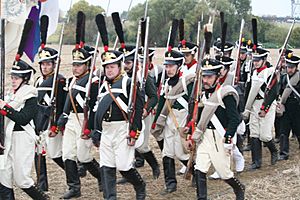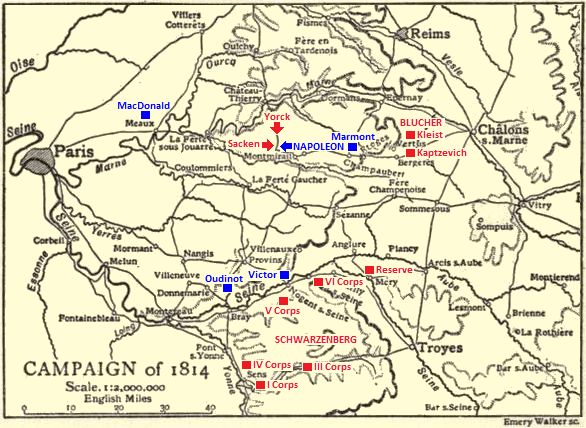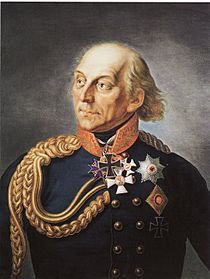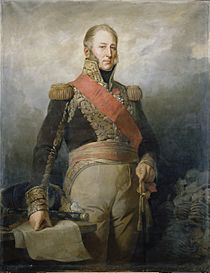Battle of Château-Thierry (1814) facts for kids
Quick facts for kids Battle of Château-Thierry |
|||||||
|---|---|---|---|---|---|---|---|
| Part of the Campaign of France of the Sixth Coalition | |||||||
 Historical reenactors wearing 1814-style Russian uniforms during a Battle of Leipzig reenactment. |
|||||||
|
|||||||
| Belligerents | |||||||
| Commanders and leaders | |||||||
| Strength | |||||||
| 20,000 | Prussia: 17,000 Russia: 17,000 Total: 30,000-34,000 |
||||||
| Casualties and losses | |||||||
| 400–600 killed, wounded, or captured | Prussia: 1,251 killed, wounded, or captured 6 guns lost Russia: 1,500 killed, wounded, or captured 3 guns lost Total casualties: 2,751-3,000 killed or wounded 12 guns lost |
||||||
The Battle of Château-Thierry took place on February 12, 1814. It was a fight where the French army, led by Emperor Napoleon, tried to defeat a Prussian army group (called a corps) led by Ludwig Yorck von Wartenburg and a Russian corps led by Fabian Wilhelm von Osten-Sacken. Even though the French chased them closely, the Prussian and Russian forces managed to escape across the Marne River. However, they lost many more soldiers than the French. This battle was part of the Six Days' Campaign, a series of quick victories Napoleon won against the Allied forces. Château-Thierry is about 75 kilometers (47 miles) northeast of Paris.
After beating Napoleon at the Battle of La Rothière, the Allied army split up. One part, led by Austrian Field Marshal Karl Philipp, Prince of Schwarzenberg, moved west. The other part, led by Prussian Field Marshal Gebhard Leberecht von Blücher, marched northwest towards Paris. Napoleon, with fewer soldiers, left some of his army to watch Schwarzenberg. He then quickly moved north to attack Blücher's army, which was spread out. Napoleon first crushed a Russian corps at the Battle of Champaubert on February 10. The next day, he defeated Sacken and Yorck at the tough Battle of Montmirail. As the Allied troops rushed towards the bridge at Château-Thierry to cross the Marne River, Napoleon chased them. He wanted to completely destroy Yorck and Sacken's forces, but they managed to get away. Soon after, Blücher advanced with more troops, leading to the Battle of Vauchamps on February 14.
How the Battle Started
After their victory at the Battle of La Rothière on February 1, 1814, the Allied armies felt very confident. Blücher and his generals thought the war would end soon. To make it easier to get supplies, Blücher's army was allowed to take a more northern route. Schwarzenberg's army would march west through Troyes, while Blücher's army would move towards Châlons-sur-Marne and then west along the Marne River valley. Russian troops under Peter Wittgenstein and a group of Cossack scouts were supposed to connect the two Allied armies. At this time, the Allies had about 200,000 soldiers, while the French had only 70,000.
The Allies completely lost track of Napoleon's army as it retreated. By February 4, Schwarzenberg started to worry about his left side and moved Wittgenstein's corps south, away from Blücher. On February 5, a Russian general moved the Cossack scouts even further away without telling Blücher. For the next few days, Blücher mistakenly believed the scouts were still watching his left side. Meanwhile, Napoleon began planning to attack Blücher's army. Napoleon thought his marshals, Claude Perrin Victor and Nicolas Oudinot, could hold off Schwarzenberg with 39,000 soldiers. So, Napoleon gathered 20,000 infantry (foot soldiers) and 10,000 cavalry (horse soldiers) to attack Blücher.
By February 8, Blücher's army was spread out over 44 miles (70 kilometers). The westernmost part was Sacken's cavalry at Viels-Maisons, with his infantry at Montmirail. Sacken was chasing Marshal Jacques MacDonald's 10,000 French soldiers. Yorck's corps was also following MacDonald and reached Dormans. Another Russian corps, led by Zakhar Dmitrievich Olsufiev, was 12 miles (19 km) east of Sacken at Étoges. Two more corps, one Russian and one Prussian, were 25 miles (40 km) further east at Châlons-sur-Marne. On February 9, as everyone marched west, Sacken reached La Ferté-sous-Jouarre, and Yorck got close to Château-Thierry.
On February 9, Napoleon arrived at Sézanne with his best soldiers, the Imperial Guard. They had a tough march on muddy roads, and local farmers even helped pull the cannons. That day, Schwarzenberg asked Blücher for help. Blücher, following orders, set out on February 10, moving southwest towards Sézanne. As they marched, they heard cannons in the distance. This was Napoleon's army attacking Olsufiev's smaller corps at the Battle of Champaubert. Olsufiev's corps was almost completely destroyed, and he was captured. Blücher had ignored Olsufiev's messages asking for help. The few Russian survivors from this battle would suffer more losses later.
On February 11, Napoleon turned most of his army west towards Montmirail. He hoped to trap and destroy Sacken's corps between his army and MacDonald's corps. Sacken's soldiers marched all night towards Montmirail. Yorck told Sacken to retreat towards Château-Thierry, but Sacken didn't realize how much danger he was in. He thought he was fighting a small enemy force. MacDonald, however, couldn't help because he had broken a bridge over the Marne River. Yorck's tired troops were also delayed by muddy roads and were still far from Sacken. Napoleon managed to place some French soldiers at a key road crossing, stopping the two Allied corps from joining up.
At the Battle of Montmirail, Napoleon had about 10,500 soldiers and 36 cannons. He faced Sacken's 18,000 Russians. Yorck's 18,000 Prussians appeared to the north later. By 4:00 pm, Napoleon had 20,000 soldiers and attacked. The battle was fierce, especially around the village of Marchais-en-Brie. Yorck's attack from the north was pushed back. Finally, French soldiers drove Sacken's men out into the open, where French cavalry attacked them. Yorck's late arrival probably saved Sacken's corps, which retreated north that evening. Sacken's corps lost 2,800 soldiers and 13 cannons. Yorck lost 900 soldiers, while the French lost about 2,000.
The Battle Unfolds
Troop Strengths
The Action
On February 11, the Allied generals decided that Yorck and Sacken should retreat through Château-Thierry towards Reims to rejoin Blücher's main army. Napoleon started chasing the retreating Allies at 9:00 am on February 12. Marshal Édouard Mortier led the chase on the main road, while Napoleon led another group further west. Napoleon ordered MacDonald to capture the bridge at Château-Thierry.
Early on February 12, Sacken's corps passed through Yorck's lines near Montfaucon. Sacken left a small group of soldiers behind. Mortier's advance troops met the Prussian soldiers near Viffort. The Prussians were on a hill overlooking a stream. French soldiers attacked, and the Prussians had to pull back when the French started to surround them.
Further along the road, the French found another Prussian group blocking their way. While French foot soldiers attacked from the front, a large group of French cavalry (horse soldiers) led by Marshal Michel Ney moved around the Prussian left side. These were elite cavalry divisions. Napoleon also sent soldiers to capture a small village. Mortier launched a frontal attack with six battalions. Yorck, knowing he had a river behind him, ordered his supply wagons to cross to the north bank of the Marne.
Yorck ordered 3,000 Prussian cavalry to move to the left to counter the French cavalry threat. Many of these Prussian cavalrymen were less experienced soldiers. The French cavalry, including the best Guard Dragoons and Horse Grenadiers, charged. The Prussian cavalry charged too, but they were met with carbine fire. Soon, a large cavalry fight broke out.
The French cavalry won, pushing the Prussian cavalry back and causing them to retreat in confusion. The French captured two cannons. Yorck ordered his infantry to retreat, which they did in an organized way. However, some Prussian soldiers were cut off by French cavalry and suffered many losses. A Russian battalion was also caught. The Prussian Leib Regiment was cut off by French dragoons but managed to break free with a bayonet charge. French grenadiers pushed the Prussian right side almost to Château-Thierry. A Russian general tried to retreat with his two regiments, but after running out of ammunition, they were captured along with three cannons.
A group of French cavalry circled around Nogentel. As the Prussian column came out of the village, the French cavalry charged, causing many casualties and capturing two more cannons. As the Prussian soldiers retreated into Château-Thierry, a small group of Prussians formed the rear guard to protect the others. They fought their way to the pontoon bridge, but by then, it had been destroyed. The 400 surviving Prussian soldiers had to surrender. Prussian cannons firing from the north bank of the Marne River stopped the French from chasing them further.
Outcome of the Battle
Historians say that the Prussians lost about 1,250 soldiers and the Russians lost 1,500. The French lost fewer, around 600 soldiers. The French also captured nine cannons and many supplies. Other reports say French losses were between 400 and 600, while Prussian and Russian losses were higher, around 2,751 to 3,000 soldiers. That evening, the Allied corps retreated north to Oulchy-la-Ville.
Because the French army didn't have equipment to build bridges quickly, it took a whole day to rebuild the Château-Thierry bridge. Once it was ready, Mortier led French troops in pursuit of the Allies. They captured 300 to 400 stragglers and found many artillery wagons that the Allies had destroyed during their quick retreat.
Napoleon was very proud of his Guard, saying they "covered themselves with glory." However, he was very disappointed that he couldn't completely destroy Sacken and Yorck's forces. MacDonald had not moved quickly enough to capture the important Château-Thierry bridge. The next day, Yorck's troops marched to Fismes, and Sacken moved to Reims. Blücher, who had been waiting for news, finally realized Napoleon was not retreating. On February 13, Blücher began pushing west with his other corps, leading to the Battle of Vauchamps.
|





